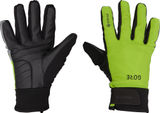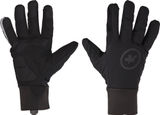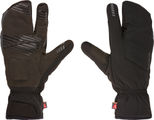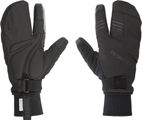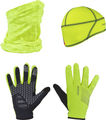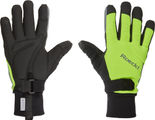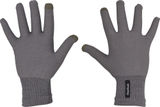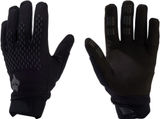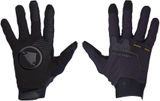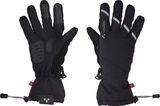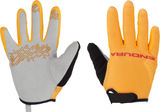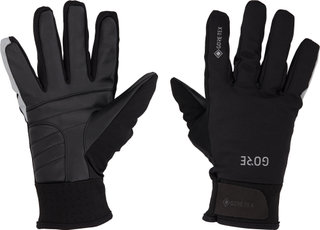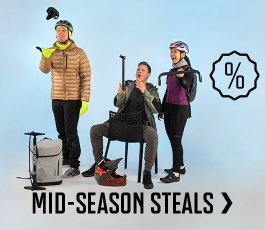Gloves
OUR Gloves RECOMMANDATIONS
Our Suggestions
Bike gloves protect against rain, wind, cold, UV light and even minor injuries, and also provide comfort and control. That's why it's hard to imagine MTB, gravel and road cyclists without them. If you use your bike for commuting or travelling, a good pair of bike gloves is essential. View Guide
The Most Important Features for Bike Gloves
Depending on the intended use, there are particularly thin and breathable gloves, or waterproof or windproof bike gloves. What they all have in common is that the material used on the palm is usually much more robust than on the backhand. The most noticeable feature that distinguishes bike gloves from one another is the finger length:
- Short or half-finger gloves leave the fingertips free. This ensures good ventilation and a very natural feel. Performance-oriented riders who use a head unit during races will appreciate this just as much as touring cyclists looking for change to pay for a snack.
- Full-finger or long-finger gloves enclose the entire finger and provide plenty of grip on the brake or gear levers, even with very sweaty hands or in heavy rain. They also offer more protection against abrasions and UV radiation. Thinner versions for summer with airy fabric on top are not warmer than half-finger gloves. With some gloves, slightly-conductive fabric panels on the fingertips ensure that you can easily operate your smartphone’s touchscreen.
Road Bike Gloves
Short-fingered gloves are very popular with roadies. Ventilation and tactility are crucial here when you have to fish out a packet of energy gel from your jersey pocket and then open it during a race. Gravel and cyclocross fans tend to favour designs intended for drop bars, but the longer full-finger gloves also make a good option.
MTB Gloves
For most mountain biking disciplines, long-finger gloves are number one. The more gravity-oriented, the better. This is where grip and protection stand out – and in technical terrain, it’s forbidden to take your hands off the bars to grab an energy gel, use a smartphone or bike computer anyway. In cross-country and marathon racing, however, short-finger gloves remain popular.
Gloves for Touring and Everyday Life
If you want to wear your gloves on tours or in everyday settings, there are many options to consider, depending on which qualities are most important to you. Warm, padded, waterproof or windproof – paying attention to features helps here.
Bike Gloves for Every Discipline and Purpose
Bike gloves – whether they’re half-finger or full-finger – are used for very different purposes, each of which determines the design. Not all features can be combined without problems, so you’ll have to figure out which ones you value the most.
- Comfort: With their soft, robust textile-based materials (mostly modern synthetic leather), bike gloves form a barrier between your skin and handlebar grips. The material also absorbs moisture and thus ensures a pleasant feel. For those with hand issues, soft gel pads can help absorb shocks and vibrations from the handlebars. If your focus is on comfort, finger length is purely a matter of taste.
- Warmth & weather protection: This is where long-fingered gloves show their full strength. They are available in waterproof, windproof or lined designs.
- Protection: In the event of a fall, gloves primarily protect you from abrasions or prevent dirt from getting into a fresh wound. People who work a lot with their hands appreciate this especially. In addition, long-finger gloves protect hands from scratches or minor cuts when you’re mountain biking on an overgrown trail. Thirdly, gloves provide protection from harmful UV radiation.
- Grip: Gloves improve your grip on your bike’s handlebars and enable you to operate your brake levers, shifters or dropper posts more safely. Your hands won’t slip, even in wet conditions.
- Visibility: Bike gloves with reflective materials or colours for increased visibility are available on request. Tip: Check our "Product Features" filter and select the "high-visibility” filter!
Bike Gloves for Winter, Spring or Autumn: The right pair for every season
For many people, warmth is the most important reason to wear gloves while riding. This makes sense because you lose a lot of body heat through your extremities (e.g. hands, feet, head). And cold hands are not only a matter of comfort when biking: it’s also a matter of safety. If your hands are cold, clammy or wet, you have less control over the brakes and handlebars. However, you can do something about it.
- Windproof bike gloves: Thanks to special materials or the use of a windproof membrane, windproof bike gloves prevent you from experiencing wind chill. They are also mostly water-repellent, although not completely waterproof. Since not much extra material is needed, windproof designs usually offer a very good feel for the handlebars and high degree of tactility while maintaining their breathability. That is why they are particularly popular for sports as well as transitional weather.
- Waterproof bike gloves keep your hands dry even in heavy rain. They are also automatically windproof and offer totally reliable protection from cold and wet weather. However, waterproof gloves are much more difficult to make than, for example, waterproof trousers or jackets. This is because there is so little space available and the requirements for a precise fit, seamlessness and so on are very high. That's why waterproof gloves are usually a bit bulkier and less tactile than their windproof siblings. Tip: For short distances or in competition, windproof and water-repellent gloves are usually sufficient. For ultimate weather protection and long-distance travel, opt for the waterproof model.
- Winter/thermal gloves: In addition to a windproof or waterproof construction, thermal gloves are lined. This starts with fleece linings and extends to synthetic fibre insulation, such as those normally used in sleeping bags and thermal jackets. Cold hands are a thing of the past with gloves like these. Note, however, that winter bike gloves are also significantly thicker than unlined gloves and therefore your control over the handlebars and brakes as well as breathability will decrease. For bikepacking trips or long commutes in winter, “pogies,” or muffs that are bolted directly to the handlebars, can serve as an alternative.
- Special case - Mittens: Because you need your fingers when biking, for example to shift gears and brake, mittens aren’t commonly used. However, there is one special feature they do have. Mittens with moulded thumbs and index fingers and closed finger chambers for middle, ring and little fingers (also called "lobster gloves" in English because of their shape) exist in the bike world and promise a lot of warmth and proper bike handling even in freezing cold.
The Most Important Facts About Bike Gloves in a Nutshell
- Why should I wear bike gloves?
Bike gloves protect hands from wind, rain, UV light and minor injuries and give the wearer more control over the bike. - Which bike gloves should be worn in winter?
Windproof or waterproof gloves protect against chill. Lined thermal gloves are suitable for very cold temperatures. - What size bike gloves?
This varies from manufacturer to manufacturer. Check the size chart on the product page for a more detailed overview. - How should bike gloves fit?
Close-fitting and wrinkle-free, without constricting. Thermal gloves in particular should not be skin-tight, as the layer of air between the glove and the hand provides warmth. Watch out for any annoying seams. - Which bike gloves for men and women?
Most bike gloves are unisex by design. For any sex, the fit as described is crucial. - Which manufacturers offer bike gloves?
Many bike gloves come from specialist glove manufacturers such as Roeckl or GripGrab or from textile professionals such as Endura, Giro, Assos, Gore Wear or VAUDE. There are also bike gloves from helmet and protective gear brands such as Fox Head, Troy Lee Designs, 100 or POC, from ergonomics experts such as Ergon or full-range suppliers like Specialized or Scott.







